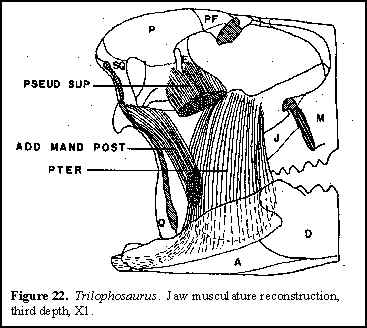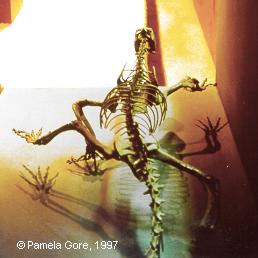 Trilophosaurus
Trilophosaurus| Archosauromorpha | ||
| The Vertebrates | Trilophosauria |
| Vertebrates Home | Vertebrate | Vertebrate |
|
Abbreviated Dendrogram
Diapsida
├─Lepidosauromorpha
│
└─Archosauromorpha
╞═"Protorosauridae"
└─┬?─Choristodera
├?─Chelonii (molecular phylogeny)
├?─Helveticosaurus
└─┬─Rhynchosauria
└─┬─Trilophosauridae
└─┬─Prolacertiformes
├─Drepanosauridae
└─Archosauria
|
Contents
Overview |
 Trilophosaurus
TrilophosaurusThere is something a little magical about holding a rare paleontological manuscript, even if it is only a moderately obscure thesis from scarcely thirty years ago. Just for a moment, you can be perhaps the sole possessor of some arcane shard of knowledge which few have seen and all but you have lost or forgotten. For a brief interval you can empathize with the cackling grey-beard medieval alchemist gloating over a treasured, rotting manuscript; or the last, most-favored student of the half-senile musical pandit who has just learned a final and most secret bandish from the lips of his dying master.
Its a strange and unique experience, but a really dangerous way to run a science. Recently I was able to obtain Peter Parks' 1969 master's thesis on the cranium of Trilophosaurus. I'm not sure how many copies exist, but the library copy I borrowed, perhaps the only one in general circulation, was poorly bound and lacked a number of important figures. I understand that more work is being done on the beast. However, until that is published, Parks 1969) remains one of the very few sources of detailed anatomical information on this unusual early archosauriform. One of the others, a University of Texas publication from the 1940's, is even more difficult to locate. Gregory, JT (1945), Osteology and relationships of Trilophosaurus. U. Tex. Publ. No. 4401: 273-359
 The gist of Parks' work is that Trilophosaurus evolved in such a way that its braincase and cranium had a very strong vertical orientation. Parks reconstructs the jaw musculature in detail and argues that the jaw was capable only of simple orthal (vertical) chomping, with no grinding. The long vertical runs of muscle must surely have permitted a strong, rapid bight which probably aided the presumed beak to clip vegetation efficiently. Parks argues from this data, and from the pattern of wear facets, that Trilophosaurus fed primarily on rough, silicate-containing vegetation.
The gist of Parks' work is that Trilophosaurus evolved in such a way that its braincase and cranium had a very strong vertical orientation. Parks reconstructs the jaw musculature in detail and argues that the jaw was capable only of simple orthal (vertical) chomping, with no grinding. The long vertical runs of muscle must surely have permitted a strong, rapid bight which probably aided the presumed beak to clip vegetation efficiently. Parks argues from this data, and from the pattern of wear facets, that Trilophosaurus fed primarily on rough, silicate-containing vegetation.
In fact, these observations may lend themselves to an alternate interpretation. The wear facets are not notably deep or common. The really striking thing about the skull is its consolidation and height. This was a skull designed to deliver and withstand very sharp, rapid shocks, presumably with a reasonably sharp beak, and then further cut its food rather finely. This suggests perhaps a strongly fibrous food source, or one covered by a hard external layer: a woody fern or something on that order.
Whatever the story may be, we should know more in a few years. --ATW 000618 Revised ATW030808.
 |
|
Trilophosaurus © 1997 Pamela Gore (Georgia Perimeter College); reproduced by permission. |
Trilophosauridae: Trilophosaurus.
Range: ?Early Triassic to Late Triassic of North America.
Archosauromorpha::: (Prolacertiformes + Archosauriformes) + *.
Similar to Rhynchosaurs, 2-3 m. Skull 10-15 cm long; dermal bones smooth; premaxilla and opposite surface of dentary without teeth, possibly with horn beak; snout very narrow; cheek teeth expanded transversely to sharp slicing surfaces; lower temporal fenestra and maxillary fenestra absent; orbits large, high on skull, and closely spaced on the narrow skull; orbits extensively floored by jugals and palatines; lacrimal small, not reaching nares; septomaxilla absent; skull highly consolidated, with sides tall and essentially vertical; dorsal surface of skull table dominated by large, wide fenestrae; high, narrow parietal crest between upper fenestrae; post-temporal bar narrow, overhanging occiput; quadrate tall with a marked posterior notch; tabulars, postparietals and supratemporals absent; wide, somewhat elongated ventral spines; heavy tail with long, heavy chevrons; no suggestion of upright carriage; phalanges very long; herbivorous.
Image: Trilophosaurus © 1997 Pamela Gore (Georgia Perimeter College); reproduced by permission.
Links: Mesozoic; Reptilian Systematics; Untitled Document; trilophosaurus Douglas Henderson image); New Page 1; Centre Consolidated School, Geology Page (kids' site, but very well done); IS NOT A PROCOLOPHONID- DATA FROM A ... abstract); Natural Canvas Fossils - Reptiles 1 some very nice teeth); Trilophosauria Mikko); 川崎悟司イラスト集・トリロフォサウルス Japanese).
ATW030825.
checked ATW050908
Using this material. All material by ATW is public domain and may be freely used in any way (also any material jointly written by ATW and MAK). All material by MAK is licensed Creative Commons Attribution License Version 3.0, and may be freely used provided acknowedgement is given. All Wikipedia material is either Gnu Open Source or Creative Commons (see original Wikipedia page for details). Other graphics are copyright their respective owners